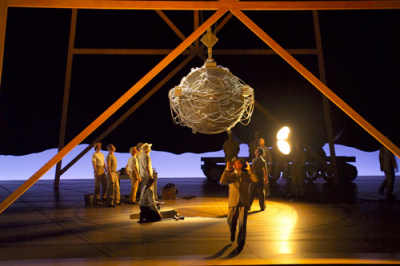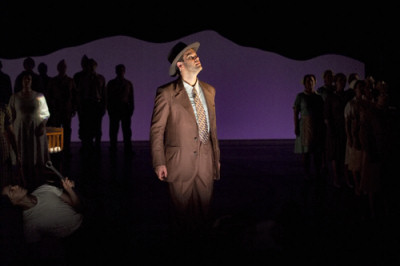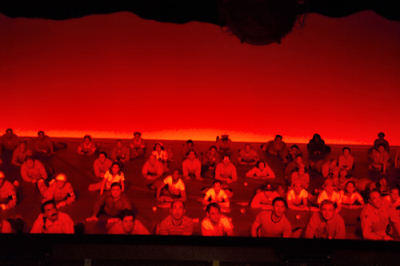John Adams, Doctor
Atomic (world premiere) San Francisco Opera, Donald Runnicles,
conductor, 5.10. 2005 (HS)

The world changed at
dawn July 16, 1945, in Alamogordo, New Mexico, when the United
States successfully detonated an atomic bomb. Ever since,
the threat of nuclear annihilation has been a rip current
making all our lives more turbulent. Doctor Atomic, composer John Adams' new opera, strives to grapple
with these ramifications as it focuses on J. Robert Oppenheimer,
the title character and the physicist who led the scientific
team that figured out how to make the bomb work -- and later
anguished over what he had done.
The stage director is
Peter Sellars, who also directed
Adams' previous operas, Nixon
in China and The Death of Klinghoffer,
and the oratorio El
Niño. Alice Goodman, his previous librettist, bowed out
of this project early on. Sellars stitched together the libretto from historical materials
and poetry that had meaning to the principal characters in
real life. Adams and Sellars focus
on the six hours or so leading up to the test detonation.
The opera becomes a rumination on the meaning of what they
were doing in that summer as World War II drew to a close.
The opera premiered
on October 1 at San Francisco Opera, which commissioned it.
In the second performance, seen this week, the work stands
revealed as a strange beast. There are some big moments, both
musical and dramatic. The' music rises to the occasion at
several points to create mesmerizing set pieces. But in the
end, it is neither dramatically cogent nor musically consistent
enough to achieve its lofty goals.
Events of that night
were dramatic. An electrical storm raged in the final hours,
raising fears that it might detonate the bomb prematurely
with workers still swarming around it. Everyone worried that
their radical design might fail, leaving president Harry S
Truman with no trump card to play at the Potsdam talks beginning
the next day. But Sellars and Adams
seem less interested in the drama than the inner torments
of Oppenheimer and the other key members of the team.

After a first half-hour
of frenetic activity, the rest of the opera settles into a
series of scenes in which the characters argue with each other,
worry about the outcome and what it all means, and, for the
biggest set pieces, quote poetry. The problem with Sellars'
libretto is that it leans so heavily on direct quotations
from John Donne's Holy Sonnet XIV, Muriel Rukeyser's Easter Eve 1945, and the Bhagavad Gita. Adams'
musical settings carry tremendous power, but these moments
fit awkwardly with the prosaic waiting and worrying surrounding
them. Quoting poets makes the characters sound like college
intellectuals spouting the latest book they read instead of
thinking, feeling human beings.
Another problem is an
oddly inert dramatic flow. Basically, nothing happens. Instead,
Sellars compensates with striking visuals. There are eight
dancers who move through many of the scenes. The most powerful
image is of the bomb hanging over the stage like a sword of
Damocles. The second act curtain goes up on the bomb hanging
over a baby's crib like a grotesque mobile. The image remains
through most of the second act, to the point where we almost
become inured to it -- just as we thought less and less about
threat of nuclear extinction over the years.
The cast is impressive,
especially baritone Gerald Finley as Oppenheimer. Baritone
Richad Paul Fink voices a contentious Edward Teller (who later
would lead the team that developed the hydrogen bomb) and
bass Eric Owens brings a stubborn military bearing to General
Leslie Groves, the Army's project head. Mezzo soprano Kristine
Jepson delivers on a couple of dramatic scenes as Oppenheimer's
alcoholic wife, Kitty, and contralto Beth Clayton lends a
certain gravitas to Pasqualita,
the Oppenheimers' Indian maid. They,
and a supporting cast that includes baritone James Maddalena (who has been in all of Adams' operas), tenor Thomas
Glenn and Jay Hunter Morris, lavished a strong commitment
to the work.
The problem is that
Adams' vocal lines are weak. They are not distinctive enough
to give these characters music that tells you much about what
kind of individuals they are. As a result, the characters
remain undeveloped. The real stuff happens in the orchestra,
which never stops underlining, commenting and growling with
portent.
Adams' music starts
off with an electronic soundscape,
emanating from speakers around the opera house, intending
to evoke the feeling of a cyclotron revving up. (A similar
soundscape uses the sounds of rain
and thunder in a second-act interlude.) The musical language
in the first scene is busy, batteringly
dissonant, rhythmically jagged, complex. The main things we
learn are that the thousands of people on the project are
pressing to get things done, and some of the scientists want
to petition Truman not to use the bomb on Japan without warning.
The music becomes tender
and lyrical in the next scene, as Robert and Kitty trade lines
from Baudelaire's erotically charged poetry, almost get into
a sex scene, only to have Robert rush off to duty. Left alone,
Kitty gets the first big aria, to a Muriel Rukeyser
poem longing for peace in a world that has concentration camps.
Scene iii takes us to
the bomb test site, which Oppenheimer has named Trinity after
the Donne sonnet which begins "Batter my heart, three
person'd God." The bomb is
hoisted into place. General Groves berates a meteorologist
for not providing good weather, then complains to Oppenheimer
about his difficulty losing weight. The scene climaxes with
Oppenheimber singing the Donne poem
to a complex orchestral underlay of intricate polyphonic music
evocative of Palestrina. The image is also striking. A white
shroud has been lifted around the tower to hide the bomb,
one flap partially opened to let the white light stream out
onto the stage. The image evokes the Old Testament tabernacle.
Finley sings in this shaft of light, displaying a baritone
that reaches to the highest range without strain, singing
with purity and real grace.

Act II begins with another
long soliloquy by Kitty from Easter
Eve 1945. The orchestra plays a gorgeous rain interlude
and Pasqualita sings a lullaby to the rain (which, as desert dwellers,
her people welcome, as opposed to General Groves).
Thunder and lightning
punctuate the next scene at the bomb tower, raising fears
that the storm will cause a disaster. Some of the scientists
wonder if the bomb could set off a chain reaction that would
encircle the globe. The music for this scene tends to be quiet,
and nervous. It got me biting my nails.
In the final scenes,
subtitled "Countdown," everyone seems to be having
visions. There is a Native American corn dance. Oppenheimer
nearly has a nervous breakdown. In the most brilliant of these
interludes, the stage goes bright, garish colors light the
background and the chorus sees the bomb as a terrifying vision
of Vishnu, as described in the Bhagavad Gita. Adams' music for this scene is sensational, a tremendous
welling up of multiple rhythms, vivid harmonies, stunning
choral writing and technicolor orchestration.
For the final moments
of the countdown, the stage is filled with prostrate soldiers
and scientist awaiting the blast. The music for this scene
plays with time, using Adams' off-center rhythmic sense to
stretch a two-minute countdown to nearly six minutes of music
that ratchets up the tension while remaining eerily, hauntingly
beautiful.
There is no explosion.
Instead the opera ends in silence, except for a final brief
soundscape in which a woman speaks in Japanese.
After all that buildup,
it is not a satisfying ending. The idea makes sense, but in
the end it is as if the bomb had fizzled out. Understandably,
Sellars and Adams did not want to
create a special effect. As Sellars
put it in a pre-performance talk, "Oedipus Rex is not
about what it looks like to gouge out his eyes, but why he
does it." Maybe so, but Sophocles does not end the play
with Oedipus going offstage to do the deed. We see the bleeding
result. Doctor Atomic
leaves us hanging.
Oppenheimer's scene
quoting the Donne sonnet and the big choral explosion of the
Vishnu scene are, for me, the vocal highlights. If and when
Adams extracts an orchestral suite from this opera, it will
be worth hearing in the concert hall, especially such items
as the rain interlude and the music for the final scene. But
as a complete opera, it works only in fits and starts. Further
productions are scheduled at the Lyric Opera of Chicago and
De Nederlandse Opera, which co-produced
the work. We will see if Sellars
and Adams do something to pull it all together better.
Harvey Steiman
Photographs © San Francisco
Opera





